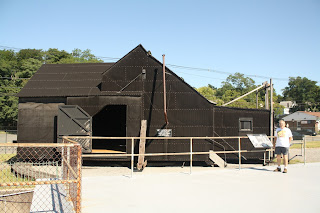ALONG THE HUDSON RIVER
SUMMER TRAVELS-- New York 2015
 |
Hiking to the lighthouse offered beautiful views of the
wild flowers along the Hudson Riverbank in New York. |
In between days of working around Tara's house while we cat-sat, Andy and I visited New York vacation spots. One such tourist mecca is the Saugerties Lighthouse on the Hudson River near Kingston.
 |
Stepping carefully from one dry sand
patch to the next, Andy checks out the
birds that gather along the shore. |
Now a bed and breakfast available on a limited basis to the public, the lighthouse was first operated in 1869 to guide river traffic up and down the Hudson River. It was automated in 1954. Vacant for decades, the building fell into disrepair. Preserved from demolition, the lighthouse was placed on the National Register of Historic Places in 1979. Renovations began in 1986, and the navigational beacon was restored to operation in 1990.
 |
Picnic tables allow visitors
to relax and enjoy the
atmosphere of the river. |
The lighthouse is owned and maintained by the Saugerties Lighthouse Conservancy, a private non-profit organization dedicated to preserving this historic landmark, that is part of our maritime heritage. The Saugerties Lighthouse Conservancy receives no local, state or federal funding.
Tour are conducted on Saturdays and Sundays, from noon to 3 p.m., Memorial Day through Labor Day, by appointment only. Two second-floor bedrooms are offered for overnight stays to fund the preservation of the lighthouse and the attached property.
When we inquired about reservations, we learned that reservations for the lighthouse overnight stays were booked a year in advance. Obviously a popular place, the lighthouse and grounds included a circular deck with six or eight picnic tables and a surrounding pebble and sand beach.
 |
| Add caption |
Many of the visitors who had hiked the quarter-mile trail out to the lighthouse on this pleasant August day relaxed at picnic tables or stepped carefully along the drier spots of beach.
Andy had planned our next stop at Pratt's Rock, a high cliff face near Schoharie Creek outside of Prattsville.
 |
Carvings like this one cover
the face of the rock cliff
along the trail to the summit. |
This park, featuring huge stone reliefs, dates back into the mid-1800's when Zadock Pratt owned the land and served as a United States Congressman. Pratt represented the Prattsville area of New York from 1837 to 1839 and again from 1843 to 1845.
 |
Spectacular pastoral views in every direction await
our leisure stops at the summit of Pratt's Rock. |
The stone cliffs had been carved starting in 1845 by Andrew W. Pearse, an itinerant stone mason, at Pratt's request. It memorialized this unknown Congressman and credited Prattsville Tannery, that was ultimately closed in 1845, as the leading tannery in the United States before that time. A million dollars in sales of leather a year had been recorded at the tannery. The hides were tanned with hemlock.
We climbed to the summit for the views of the surrounding countryside. They were spectacular in this out-of-the-way and little known area of New York State.
Our final tourist destination for the day was a visit to the John Burroughs Memorial Field and Boyhood Rock near Roxbury, New York.
A nature writer from the late 1800's and early 1900's, Burroughs was close friends with Theodore Roosevelt. Burroughs, Harvey Firestone, Henry Ford and Thomas Edison earned the nickname of "The Four Vagabonds" as they traveled and vacationed together.
Burroughs was laid to rest here, his favorite place of contemplation, near the Woodchuck Lodge, which he called his writing nook.
 |
Hidden in the woods overlooking a field is the rock that
John Burroughs, American nature writer, called his own. |
Andy and I climbed up on the Boyhood Rock and read the nearby inscription: John Burroughs (1837-1921) "I stand amid the eternal ways and what is mine shall know my face." We could detect the smell of mint wafting from the wild patch below us.
In an essay called "The Gospel of Nature" from the book
Time and Change, 1912, Burroughs wrote, "How the contemplation of Nature as a whole does take the conceit out of us!" It seemed appropriate for the setting. I wondered if Burroughs had written that line as he sat on his Boyhood Rock and looked out over the scene in front of us.
 |
From this site, John Burroughs viewed the Catskill Mountains
and the world. And here he remains. |
Another quote that caught my attention was from the Burroughs essay "Still Small Voice." This appeared in
Under the Apple Trees, 1916. Andy and I could see the apple trees in the distance as we leaned again the glacial erratic boulder that had been Burroughs' favorite spot. And how pertinent the quote seemed at this time of political unrest and media scrutiny.
"The unknown, the inaudible forces that make for good in every state and community--the gentle word, the kind act, the forgiving look, the quiet demeanor, the silent thinkers and workers, the cheerful and unwearied toilers, the scholar in his study, the scientist in his laboratory--how much more we owe to these than to the clamorous and discordant voices of the world of politics and the newspaper. Art, literature, philosophy all speak with the still small voice."
 |
With placid but powerful elegance,
the Hudson River winds through the
eastern part of the state. |
 |
The highway to and from Tara's house
shows New York in a
peaceful and rural light. |
Even our drives home in the different seasons offered beautiful, albeit low key, scenery. And the Hudson River never ceases to be the focus of spectacular views.



















































